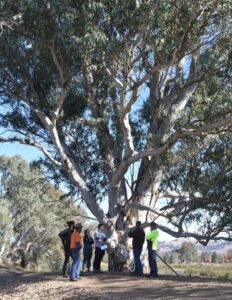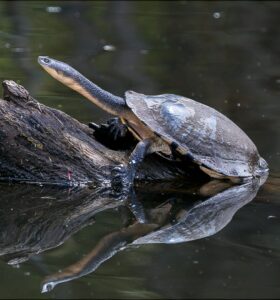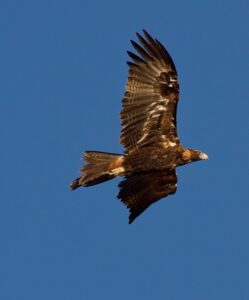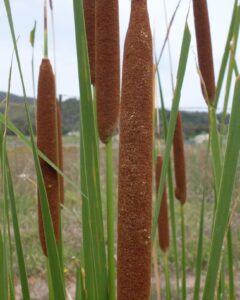In May 2024, we travelled to Albury-Wodonga to meet with local people caring for their patch of river. We were lucky enough to spend an afternoon with elders from the Duduroa Dhargal Aboriginal Corporation and learn how their project at Ryans Lagoon is restoring Country and culture.
Read on or click here to learn about some of the Indigenous plants and animals in this section of the Murray.
Standing in the dappled shade of an ancient river red gum, Uncle Allan Murray points to the entrance of this property, about 15 kilometres east of Wodonga. A gentle slope leads to a crescent-shaped lagoon, with reeds and grasses ringing the shoreline. “When the water levels were up,” he says, “there were about 100 pelicans near that gate.”
We’re at Ryans Lagoon Nature Conservation Reserve, a 165-hectare network of interconnected wetlands, on a tour with Traditional Custodians. The lagoon looks shallow at the moment, but it holds huge potential as a biodiversity hotspot for fish, frogs and birds once more water is allowed to flow naturally into the wetlands. Three wedge-tailed eagles soar overhead, which Uncle Allan calls bunjil, a revered ancestral figure.
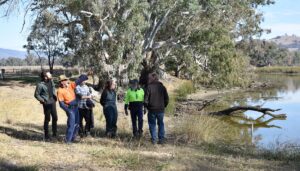
Uncle Allan Murray pointing out birdlife at Ryans Lagoon
Previously managed by Parklands Albury Wodonga, Ryans Lagoon is now under the care of the Duduroa Dhargal Aboriginal Corporation, with a three-year project to restore the landscape by thinning dense regrowth to allow more room for trees to grow, clearing weeds and controlling invasive species. They’re also promoting cultural practices, and Uncle Allan and Uncle Phil Murray have planted tea trees and wattles to mark out areas for dancing, rock art, axe-grinding and stone-knapping.
About a month ago they conducted a cultural burn to clear out invasive weeds along the banks of one lagoon, but there’s still a big task ahead. Driving through the property, Uncle Allan points out waist-high Bathurst burr and thistles on either side of the track. “If you haven’t got people to manage it,” he says, “this is what it ends up like.”
Once the weeds are cleared, the elders hope to plant an indigenous crop like Kangaroo Grass, so the grains can be harvested and ground into flour. Native grasses attract wombats, kangaroos and wallabies, as well as providing shelter for lizards, skinks and bandicoots.
We’re far from the first guests. The elders have also hosted Latrobe University academics to monitor turtle nesting and a local Landcare group to listen out for the endangered Sloane’s froglet.
Further along is a huge river red gum with its upper branches fused together to form distinctive rings. Hundreds of years ago, Uncle Allan’s ancestors trained the tree into this shape by binding branches with twine made from Cumbungi reeds, and it stands here as a reminder of their care for country. The Duduroa Dhargal elders plan to make their own ring trees, continuing this cultural practice.
At the time of our visit, the Albury/Wodonga region has gone months without decent rain, and the floodplains and surrounding hills look brown and dry. Ryan’s Lagoon is also waiting for a drink too, and there are plans to deliver environmental water in spring, either by releasing more water down the Murray to help it flood naturally into the wetlands, or by pumping water in directly.
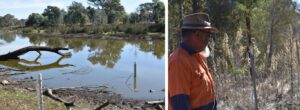
Markers in the lagoon show how low the water level is; Uncle Allan looks out over large sections of weeds that will need to be cleared
It’s a compelling example of how water secured for the environment under the Murray-Darling Basin Plan can be used to restore wetlands under the care of Traditional Custodians. But this project only lasts three years, which doesn’t provide certainty to employ young Indigenous people in a secure career, making it difficult for the elders to pass their knowledge to the next generation. Bureaucratic barriers can slow progress, and the elders need more resources and tools.
It’s also symptomatic of wider issues of water injustice. Despite caring for these waters for thousands of generations, Traditional Owners currently hold less than 0.18% of settler water rights issued in Victoria, and about the same percentage across the entire Murray-Darling Basin. With Treaty negotiations underway in Victoria, sites like this could be strong candidates for more permanent forms of Traditional Owner management, including land and water handbacks.
At the recent Yoorrook Justice Commission hearings, Victorian Water Minister Harriet Shing admitted that the state government received $83 billion in water revenue over the past decade, but none of that wealth has been passed on to Traditional Owners. As the Federation of Victorian Traditional Owner Corporations has argued in a recent media release, “our stolen water should be returned to us”.
At Ryans Lagoon, Uncle Allan and Uncle Phil are showing how impactful it can be when Traditional Custodians have the power to manage their Traditional land – to restore biodiversity, heal Country and promote cultural practices at the same time. “Water is life,” says Uncle Phil Murray. “If we had full control of this place, things would be a lot better.”

